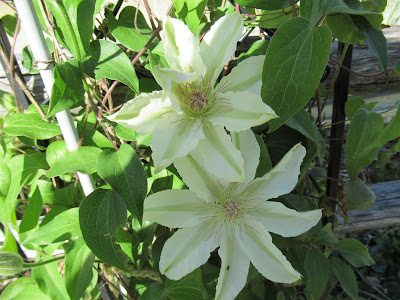Clematis 'Candida.'
I marvel each season at the coloring of these blooms, the delicate stripes of pale green against creamy white, deep rose pink of thread-like stamens.
My lilacs were a Mother's Day gift from Howard and Dawn three years ago; this is their second season to bloom, a good month earlier than could be expected in my native Vermont. The scent drifts on the lightest current of air, hauntingly nostalgic.
Several ancient lilacs grew, twisted and stunted, in the remnants of a tumbled stone wall at the lower edge of Grampa Mac's garden. Survivors of harsh New England winters, lilacs mark the grass-covered foundations of many a home long abandoned and forgotten, stand sentinel in old churchyards and burying grounds.
Each time I pass near the lilacs I am drawn to pause and bury my nose in the blossoms.
This red-purple variety is slower to open its flowers, but the scent is already discernable.
From my desk I have a view through the south window of the hummingbird feeder. My journal for 2022 notes the arrival of the first hummer on April 13th. I brewed a batch of nectar and hung the feeder on April 6th this year having observed the posted hummingbird migration charts and wanting to be sure that the birds were given a welcome.
It was 40 degrees F. at 7:30 a.m. on Monday morning when the familiar shape of a hummer zooming in for breakfast caught my eye. How quickly I have resumed the habit of glancing out the window, pausing for a moment to watch if a bird is at the feeder.
This evening the silhouette of a male hummer hovered against the pale pink and saffron backdrop of the twilight sky. I stepped quietly onto the screened porch, moved to within a few feet of the hanging feeder. A second bird flashed across the flight path of the one leaving the feeder confirming that there are now two males in residence waiting for the ladies to arrive.
I've spent two mornings pruning winter-damaged roses, raking dead leaves and grass away from the peonies, yanking up random handfuls of weeds; as I work I'm absorbing the grim truth that invasive ground covering weeds, wild onions, purple violets, fleabane, creeping buttercup, are so well entrenched that I can never eradicate them.
Coneflower seedlings have emerged in their hundreds, clumps of self-sown poppies have burst through amongst the New England asters and bee balm.
There will undoubtedly be a few frosty nights, days of chilly rain when we will again kindle a fire in the wood stove.
We work through the caprices of weather that 'spring' is bound to present, rejoicing in the renewal that unfolds daily, balm to quiet the clash and clamor of unrest and uncertainty that is too much with us.





The season is definitely off to a great start in your neck of he woods. Your clematis Candida is a real beauty. I might well say ditto to your last thoughts, and so beautifully expressed. Mary@ Hilltop Post
ReplyDeleteMary; Two more blossoms opening on 'Candida' today and one on 'Dr. Ruppel.' Each morning brings some new delight this time of year.
DeleteLilacs do bring back sweet memories. Such an old-fashioned favorite. It's a busy time of year and it looks like you have some pretty blooms already!
ReplyDeleteKaren; Lilacs are still a welcome harbinger of spring in New England. I've seen very few planted here in KY; mine were ordered from a nursery in TN.
DeleteDealing with the invasive weeds is such a problem. The main one I have is the wild bleeding heart which is lovely BUT so invasive. It must have come originally as a 'gift' from a bird but now it's popping up in so many different areas. I love lilacs and as far as I can see our bushes have made it through another winter.
ReplyDeleteI've see a Hummingbird in the park but none here in the garden. It may be a bit too early. There have been so few birds around that I can't help wondering if Miss Kitty is keeping them away.
Have a good week. Granny M
G.M. I googled wild bleeding heart. It seems fairly common in the Appalachians east of us. I haven't recognized any here in our fringe of woods along the ravines but will watch for it. Easier to spot when in bloom. Rosa multiflora grows everywhere here, also native honeysuckle--both are very invasive pests. I feel more kindly toward the purple violet--at least it stays close to the ground.
DeleteThe Clematis is lovely. My lilacs are just starting to bloom.
ReplyDeleteMichelle; I think the clematis vines are tougher than they appear--they've survived a week of frosty nights in March and are now being buffeted by a sharp west wind. The lilac bushes are still small, but thriving.
Delete